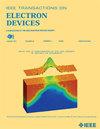Investigation of Random Telegraph Noise Scaling Dependency in 3-D NAND Using Monte Carlo Simulator
IF 2.9
2区 工程技术
Q2 ENGINEERING, ELECTRICAL & ELECTRONIC
引用次数: 0
Abstract
Random telegraph noise (RTN) shifts the threshold voltage (利用蒙特卡罗模拟器研究三维NAND中随机电报噪声的尺度依赖性
随机电报噪声(RTN)使三维闪存单元的阈值电压(${V} _{t}$)发生移位,成为器件故障的主要原因。随着设备规模的不断扩大,RTN已经成为影响设备性能的越来越重要的因素。本研究的目的是开发一个模拟器来预测RTN在缩放三维nand闪存中引起的${V} _{t}$移位的分布。以前的RTN分析方法严重依赖于大量的模拟或测量,这不仅耗时而且在预测器件缩放对RTN引起的${V} _{t}$移位的影响方面受到限制。为了解决这些限制,我们开发了一种新的RTN蒙特卡罗模拟器,该模拟器将先前开发的基于人工神经网络(ANN)的机器学习(ML)模型与陷阱占用状态的马尔可夫过程集成在一起。利用该模拟器,我们全面分析了具有多个陷阱的三维nand器件中的RTN效应,提取了相应的衰减常数($\lambda $),并模拟了$\lambda $对器件物理参数的依赖关系。该模拟器在生成大规模RTN数据时提供了灵活性,无需额外的模拟或测量,在保持准确性的同时显着减少了计算时间。
本文章由计算机程序翻译,如有差异,请以英文原文为准。
求助全文
约1分钟内获得全文
求助全文
来源期刊

IEEE Transactions on Electron Devices
工程技术-工程:电子与电气
CiteScore
5.80
自引率
16.10%
发文量
937
审稿时长
3.8 months
期刊介绍:
IEEE Transactions on Electron Devices publishes original and significant contributions relating to the theory, modeling, design, performance and reliability of electron and ion integrated circuit devices and interconnects, involving insulators, metals, organic materials, micro-plasmas, semiconductors, quantum-effect structures, vacuum devices, and emerging materials with applications in bioelectronics, biomedical electronics, computation, communications, displays, microelectromechanics, imaging, micro-actuators, nanoelectronics, optoelectronics, photovoltaics, power ICs and micro-sensors. Tutorial and review papers on these subjects are also published and occasional special issues appear to present a collection of papers which treat particular areas in more depth and breadth.
 求助内容:
求助内容: 应助结果提醒方式:
应助结果提醒方式:


